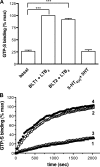Leukotriene BLT2 receptor monomers activate the G(i2) GTP-binding protein more efficiently than dimers
- PMID: 20026606
- PMCID: PMC2825429
- DOI: 10.1074/jbc.M109.083477
Leukotriene BLT2 receptor monomers activate the G(i2) GTP-binding protein more efficiently than dimers
Abstract
Accumulating evidence indicates that G protein-coupled receptors can assemble as dimers/oligomers but the role of this phenomenon in G protein coupling and signaling is not yet clear. We have used the purified leukotriene B(4) receptor BLT2 as a model to investigate the capacity of receptor monomers and dimers to activate the adenylyl cyclase inhibitory G(i2) protein. For this, we overexpressed the recombinant receptor as inclusion bodies in the Escherichia coli prokaryotic system, using a human alpha(5) integrin as a fusion partner. This strategy allowed the BLT2 as well as several other G protein-coupled receptors from different families to be produced and purified in large amounts. The BLT2 receptor was then successfully refolded to its native state, as measured by high-affinity LTB(4) binding in the presence of the purified G protein G alpha(i2). The receptor dimer, in which the two protomers displayed a well defined parallel orientation as assessed by fluorescence resonance energy transfer, was then separated from the monomer. Using two methods of receptor-catalyzed guanosine 5'-3-O-(thio)triphosphate binding assay, we clearly demonstrated that monomeric BLT2 stimulates the purified G alpha(i2) beta(1) gamma(2) protein more efficiently than the dimer. These data suggest that assembly of two BLT2 protomers into a dimer results in the reduced ability to signal.
Figures







